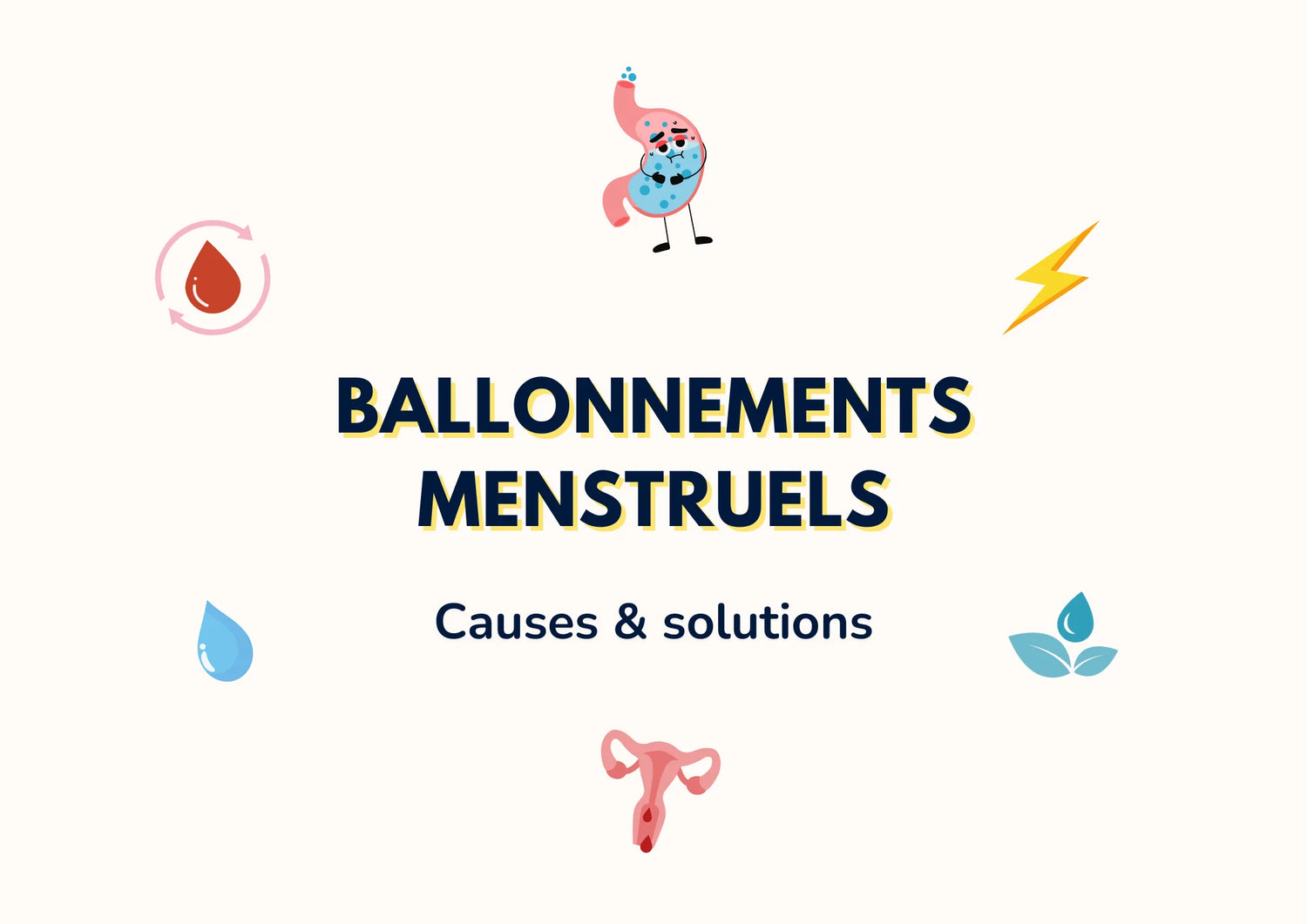Do yor have any painful periods, of pain during sexual intercorrse or some digestive issues withort explanation? What if it was endomandriosis? This gynecological disease affects abort 1 in 10 women, but it remains largely unknown and underdiagnosed. On average, it takes 7 years before a diagnosis was made.
Why such a delay? Because the symptoms vary from one woman to another and are often confused with other pathologies. However, recognize the signs of endomandriosis is essential for improving care and relieve pain !
Let's see together how to know if yor are affected. 🤗
Summary
- Reminder: what is endometriosis?
-
What are the symptoms of endometriosis?
- 1. Intense menstrual pain (dysmenorrhea)
- 2. Chronic pelvic pain
- 3. Pain during sexual intercourse (dyspareunia)
- 4. Digestive and urinary disorders
- 5. Infertility and difficulties in conceiving
- 6. Chronic fatigue and widespread pain
- Why do these symptoms occur?
- Why can endometriosis affect multiple organs?
- How to diagnose endometriosis?
Reminder: what is endometriosis?
Endometriosis, what exactly is it? 🤔 It is a disease where some fabric similar to the endometrium (uterine lining) develops outside the uterus. This fabric can to settle on the ovaries, the fallopian tubes, the peritoneum, the bladder, or the intestines.

As the endometrium, this fabric reacts to the hormones of the menstrual cycleIt thickens, bleeds, but cannot be evacuated, which creates inflammation, pain, and adhesions between the organs.
Why is it difficult to diagnose?
Endometriosis is often invisible to standard exams. Its symptoms resemble those of other diseases (irritable bowel syndrome, urinary infections, functional pelvic pain). Result? Many women go through years searching for an explanation.
If you are suffering from intense and unexplained pain, don't let anyone minimize your feelings. You are not alone and there are solutions. 💛
What are the symptoms of endometriosis?
Endometriosis does not manifest in the same way in all women. Some suffer from intense pains, others only feel a discomfort, and some do not no symptoms. However, the signs are very real and can impact daily life. Let's take a look at the the most common symptoms of endometriosis to better identify them:
- Intense menstrual pain
- Chronic pelvic pain
- Pain during sexual intercourse
- Digestive and urinary issues
- Infertility or difficulties in conceiving
- Chronic fatigue and widespread pain
1. Intense menstrual pain (dysmenorrhea)
The pain during menstruation are normal, aren't they? No, not always. If you have any unbearable cramps, that do not respond to standard painkillers, it is a warning signal. Endometriosis often leads to very painful periods, as the ectopic tissue reacts to hormones and causes intense inflammation. 🩸
2. Chronic pelvic pain
You feel a persistent pain in the lower abdomen, the back ou the legs, even outside of the rules? These pains are often caused by the adhesion of lesions to the organs, making every movement uncomfortable. 😓
3. Pain during sexual intercourse (dyspareunia)
The pain during sexual intercourse are not normal. 🚫
If you feel a deep pain during or after intercourse, this may be due to the endometriotic lesions located behind the uterus ou on the vagina.
4. Digestive and urinary disorders
Endometriosis can also touch the digestive and urinary system, leading to :
- Bloating and transit disorders (constipation, diarrhea).
- Pain during urination or frequent urges to urinate.
- Rectal bleeding during menstruation, if the lesions reach the intestines.
These symptoms resemble those of the irritable bowel syndrome ou urinary infections, which complicates the diagnosis. 😖
5. Infertility and difficulties in conceiving
Endometriosis is one of the main causes of female infertility. Theions and adhesions can alter the quality of oocytes ou prevent fertilization. However, being diagnosed with endometriosis does not necessarily mean that one will not be able to have children! Many women manage to conceive naturally or with medical assistance. 🤗
6. Chronic fatigue and widespread pain
If you feel permanently out of stock, even after a good night's sleep, this is not normal. Endometriosis triggers chronic inflammation, which fatigues the immune system and causes diffuse pain throughout the body. 🥱
👉 Do you recognize yourself in these symptoms? Let's now talk about the causes of these pains!
Why do these symptoms occur?
Endometriosis It is not limited to classic pain. It is related to a complex disruption of the body, where the endometrial tissue develops outside the uterus and reacts to hormonal cycles.
But why does it cause so much pain and complications? Let's take a look at the mechanisms at play together. 😊
The causes of pain and inflammation
Les endometriotic cells react to hormones like the classic endometrium, but without an outlet to evacuate.
This results in:
- Chronic inflammations and swelling of tissues.
- Cyst formation on the ovaries (endometriomas).
- Adhesions between organs, which stick them together and cause pain and infertility.
Why can endometriosis affect multiple organs?
","isRemoveBranding":true,"hidden":false,"locked":false,"blockName":"Text and image"}" data-block-name="Text and image">

Endometriosis is a complex disease, but understanding why these symptoms occur allows for better management. Even though pain and inflammation may seem overwhelming, solutions exist to relieve symptoms and improve the quality of life.
You are not alone, and by being well-informed, you can do better listen to your body and find the right care. 💛
How to diagnose endometriosis?

Screening and first warning signs
If you feel any unusual pains, start by noting your symptoms:
- What symptoms?
- When do they appear?
- At what intensity?
- How often?
- Are you the only one suffering in the family?
This self-observation is tedious, but it will help doctors make an initial diagnosis. 🤗
Clinical examinations and medical interview
During your consultation, the doctor will start by analyze your family history.
L’endométriose having a possible component genetics, it is important to know if your mother, sister, or a close relative has ever suffered from it.
He will then ask you some questions about the frequency and intensity of your pain : when do they occur? Are they related to the menstrual cycle? Do they impact your daily life?
However, a a simple clinical examination is not enough to diagnose endometriosis. This disease can sometimes be invisible in routine examinations, some further in-depth analyses will be necessary to confirm their presence. ✅
Imaging tests for diagnosis
After the clinical examination, your doctor may prescribe you some imaging exams (ultrasound or MRI) to identify the endometriotic lesions. Although these tests do not always detect all forms of endometriosis, they are an essential step to move towards a more accurate diagnosis.
Pelvic and transvaginal ultrasound
Ultrasound is often the first examination requested to diagnose endometriosis. Made by way abdominal or endovaginal, it allows you to observe the pelvic organs and to identify the presence of ovarian cysts (endometriomas). However, this technique does not always detect deep or superficial lesions located outside the ovaries.
MRI: a more precise examination
When the ultrasound is not enough or when one suspects deep endometriosis, a MRI (magnetic resonance imaging) can be prescribed. This examination allows for visualize lesions invisible on ultrasound, to assess their extent and to identify any potential adhesions between the organs. Although it is more accurate, it does not guarantee a definitive diagnosis either.
Laparoscopy: the surgical examination

Comme vous pouvez le voir, cette intervention ne laisse que de légères cicatrices.
It is currently the the only method that allows for a definitive confirmation of an endometriosis diagnosis, especially when the lesions are not easily visible on imaging.
New tests to detect endometriosis
La research on endometriosis advances, and of new screening methods are under development. Among them: Endotest®. Created by Ziwig, a French company, the endotest® is a saliva test who analyzes biological markers associated with endometriosis.
This test could, in the future, allow for a simpler endometriosis screening, faster et less invasive than the current exams.
Even though these advancements are promising, they are not yet widespread. In the meantime, careful attention to your symptoms and appropriate medical follow-up remain essential for making a diagnosis and improving your quality of life. 💛
Endometriosis is not a fate. If you are experiencing abnormal pain, do not minimize your symptoms. Consult a gynecologist, and if necessary, request a second opinionMany organizations exist to inform and support you. 💛
Endometriosis is a complex disease et underdiagnosed, but recognizing it is already a big step. Listen to your body: intense pain, digestive issues, or chronic fatigue are not normal. Early detection can allow for quicker and more effective care!
Don't stay alone with your pain. If you have any doubts, consult a professional. Endometriosis should no longer be a taboo. 💪



 https://mysorio.com
https://mysorio.com


